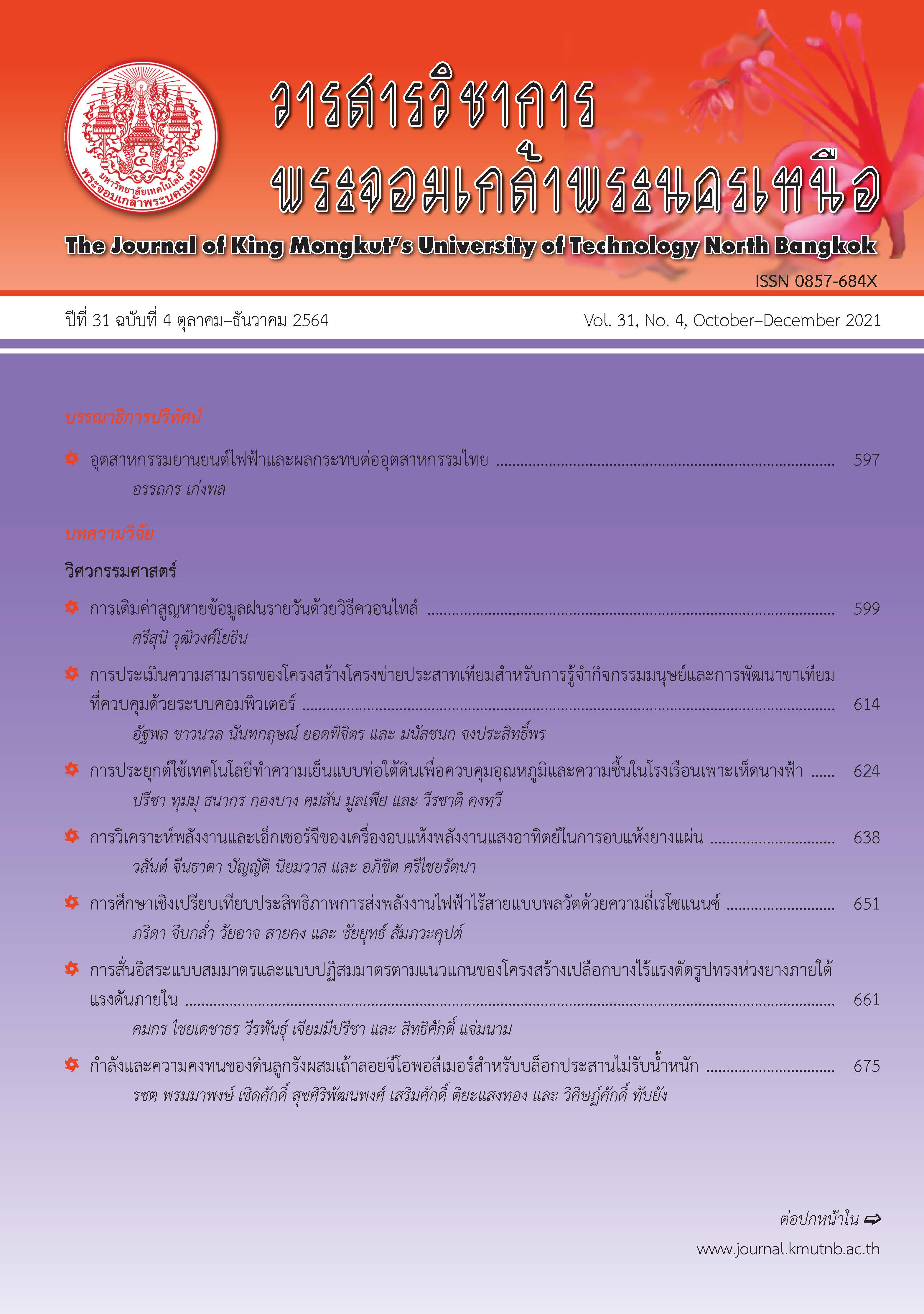ความสามารถเทได้ สมบัติทางกล และการต้านทานซัลเฟตของคอนกรีตชนิดไหลตัวได้ผสมวัสดุสามประสาน
Main Article Content
บทคัดย่อ
งานวิจัยนี้มีวัตถุประสงค์เพื่อศึกษาความสามารถเทได้ สมบัติทางกลและการต้านทานสารละลายซัลเฟตของคอนกรีตชนิดไหลตัวได้โดยผสมวัสดุสามประสาน ปูนซีเมนต์ปอร์ตแลนด์ประเภทที่ 1 แทนที่บางส่วนด้วยเถ้าลอยปริมาณสูง ร้อยละ 50 60 และ 70 โดยน้ำหนักของวัสดุประสาน ทั้งนี้ใช้ซิลิกาฟูมแทนที่ร้อยละ 10 โดยน้ำหนักของวัสดุประสาน โดยใช้อัตราส่วนน้ำต่อวัสดุประสานเท่ากับ 0.4 และใช้สารลดน้ำพิเศษที่ร้อยละ 2 โดยน้ำหนักของวัสดุประสาน ทำการทดสอบ หน่วยน้ำหนัก การไหลแผ่และการสูญเสียค่าการไหลแผ่ ความต้านทานการแยกตัว การก่อตัว ความพรุน การดูดซึมน้ำ กำลังอัด และการสูญเสียน้ำหนักต่อสารละลายซัลเฟต ผลการทดสอบพบว่าปริมาณเถ้าลอยในการแทนที่ส่งผลโดยตรงต่อความสามารถเทได้ของคอนกรีตชนิดไหลตัวได้ คอนกรีตแทนที่เถ้าลอยร้อยละ 70 โดยน้ำหนักของวัสดุประสาน พบว่าการไหลแผ่และการสูญเสียค่าการไหลแผ่ และความต้านทานการแยกตัวดีที่สุด ส่วนความพรุน และการดูดซึมน้ำ เมื่อมีการใช้เถ้าลอยแทนที่ร้อยละ 60 ผสมร่วมกับซิลิกาฟูมร้อยละ 10 โดยน้ำหนักของวัสดุประสาน พบว่ามีค่ามากที่สุด ส่วนการใช้เถ้าลอยแทนที่ปูนซีเมนต์ร้อยละ 50 โดยน้ำหนักของวัสดุประสาน มีการก่อตัวระยะต้นเร็วที่สุด ในขณะที่ค่ากำลังอัด และการสูญเสียน้ำหนักต่อสารละลายซัลเฟต ที่อายุ 180 วัน ให้ค่ากำลังอัดสูงสุดที่ 396.21 กิโลกรัมต่อตารางเซนติเมตร และอัตราการสูญเสียน้ำหนักมีค่าน้อยกว่าคอนกรีตควบคุม ดังนั้นการแทนที่เถ้าลอยในปริมาณสูงในคอนกรีตถึงร้อยละ 50 โดยน้ำหนักของวัสดุประสาน เป็นอัตราส่วนผสมที่เหมาะสมต่อการต้านทานสารละลายซัลเฟตของคอนกรีตชนิดไหลตัวได้
Article Details
บทความที่ลงตีพิมพ์เป็นข้อคิดเห็นของผู้เขียนเท่านั้น
ผู้เขียนจะต้องเป็นผู้รับผิดชอบต่อผลทางกฎหมายใดๆ ที่อาจเกิดขึ้นจากบทความนั้น
เอกสารอ้างอิง
[2] S. Ittiporn, B. Lalita, S.Warangka, K. Pitisan, and T. Somnuk, “Sodium and magnesium sulfate resistance of mortars with interground limestone and limestone powder replacing cements,” Journal of Advanced Concrete Technology, vol. 12, no. 10, pp. 403–412, 2014.
[3] P. Chindaprasirt, Fly Ash in Concrete. Revised edition, Bangkok: Thailand Concrete Association, 2005 (in Thai).
[4] P. Dinakar, K. Babu, and M. Santhanam, “Durability properties of high volume fly ash self compacting concrete,” Cement and Concrete Composites, vol. 30, no. 10, pp. 880–886, 2008.
[5] S. Rukzon and P. Chindaprasirt, “Strength and carbonation model of rice husk ash cement mortar with different fineness,” Journal of Material in Civil Engineering, vol. 22, no. 3, pp. 253–259, 2010.
[6] S. Rukzon and P. Chindaprasirt, “Strength of ternary blended cement mortar containing portland cement rice husk ash and fly ash,” Journal of Engineering Institute of Thailand, vol. 17, no. 2, pp. 33–38, 2006 (in Thai).
[7] P. Chindaprasirt and S. Rukzon, “Strength, porosity and corrosion resistance of ternary blended portland cement, rice husk ash and fly ash mortar,” Construction and Building Materials, vol. 22, no. 8, pp. 1601–1606, 2008.
[8] J. M. Khatib, “Performance of self compacting concrete containing fly ash,” Construction and Building Materials, vol. 22, pp. 1963–1971, 2008.
[9] H. Reianhardt and M. Stegmaier, “Influence of heat curing on the pore structure and compressive strength of self compacting concrete (SCC),” Cement and Concrete Research, vol. 36, no. 5, pp. 879–885, 2006.
[10] Standard Specification for Chemical Admixtures for Concrete, Annual Book of ASTM Standards 04. 02, C494, 2012.
[11] Standard Test Method for Density (Unit Weight), Yield, and Air Content (Gravimetric) of Concrete, Annual Book of ASTM Standards 04. 02, C138, 2012.
[12] Standard Test Method for Slump Flow of Self-Consolidating Concrete, Annual Book of ASTM Standards 04. 02, C1611, 2012.
[13] Standard Test Method for Passing Ability of Self-Consolidating Concrete by J-Ring, Annual Book of ASTM Standards 04. 02, C1621, 2012.
[14] Specification and Guidelines for Self-Compacting Concrete, European Federation of National Associations Representing for Concrete (EFNARC), 2002.
[15] Standard Test Method for Time of Setting of Concrete Mixtures by Penetration Resistance, Annual Book of ASTM Standards 04. 02, C403, 2012.
[16] Standard Test Method for Density, Absorption, and Voids in Hardened Concrete, Annual Book of ASTM Standards 04. 02, C642, 2012.
[17] Standard Test Method for Compressive Strength of Hydraulic Cement Mortars, Annual Book of ASTM Standards 04. 02, C109, 2018.
[18] Standard Test Method for Weigh Loss (Mass Loss) of Sheet Steel During Immersion in Sulfuric Acid Solution, Annual Book of ASTM Standards 04. 02, C694, 2016.
[19] P. Paisitsrisawat and U. Rattanasak, “Effect of silica fume on the properties of fluidized bed combustion (FBC) fly ash geopolymer,” The Journal of Industrial Technology, vol. 9, pp. 40-48, 2013 (in Thai).
[20] L.N. Assi, E. Deaver, and P. Ziehl, “Using sucrose for improvement of initial and final setting times of silica fume-based activating solution of fly ash geopolymer concrete,” Construction and Building Materials, vol. 191, pp. 47–55, 2018.
[21] K. Kuennokkhum, W Koraviyothin, and W. Chalee, “The effect of Na(OH) concentration on the water flow rate and compressive strength of fly ash-based geopolymer porous concrete,” The Journal of KMUTNB, vol. 24, no. 1, pp. 56–65, 2014 (in Thai).
[22] C. S. Poon, L. Lam, and Y. L. Wong, “Effect of fly ash and silica fume on interfacial porosity of concrete,” Journal of Materials in Civil Engineering, vol. 11, no. 3, pp. 197–205, 1999.
[23] P. R. Silva and J. Brito, “Experimental study of the porosity and microstructure of selfcompacting concrete (SCC) with binary and ternary mixes of fly ash and limestone filler,” Construction and Building Materials, vol. 86, no. 1, pp. 101–112, 2015.
[24] T. H. Wee, K. Arvind, K. Survavanshi, S. F. Wong, and A. Rahman, “Sulfate resistance of concrete containing mineral admixtures,” ACI Materials Journal, vol. 97, no. 5, pp. 536–549, 2000.
[25] S. Santhanam, M. D. Cohen, and J. Olek, “Mechanism of sulfate attack: A fresh look part 2. proposed mechanisms,” Cement and Concrete Research, vol. 33, no. 3, pp. 341–346, 2003.

